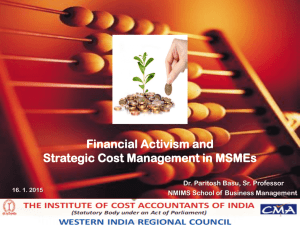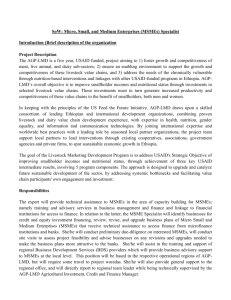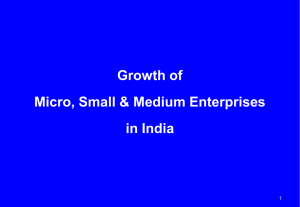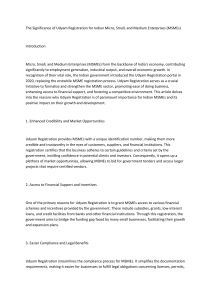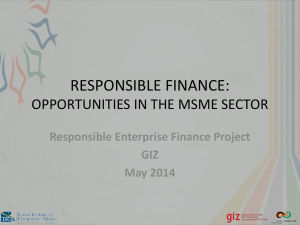Role of Micro Small and Medium Enterprises for sustaining India`s
advertisement
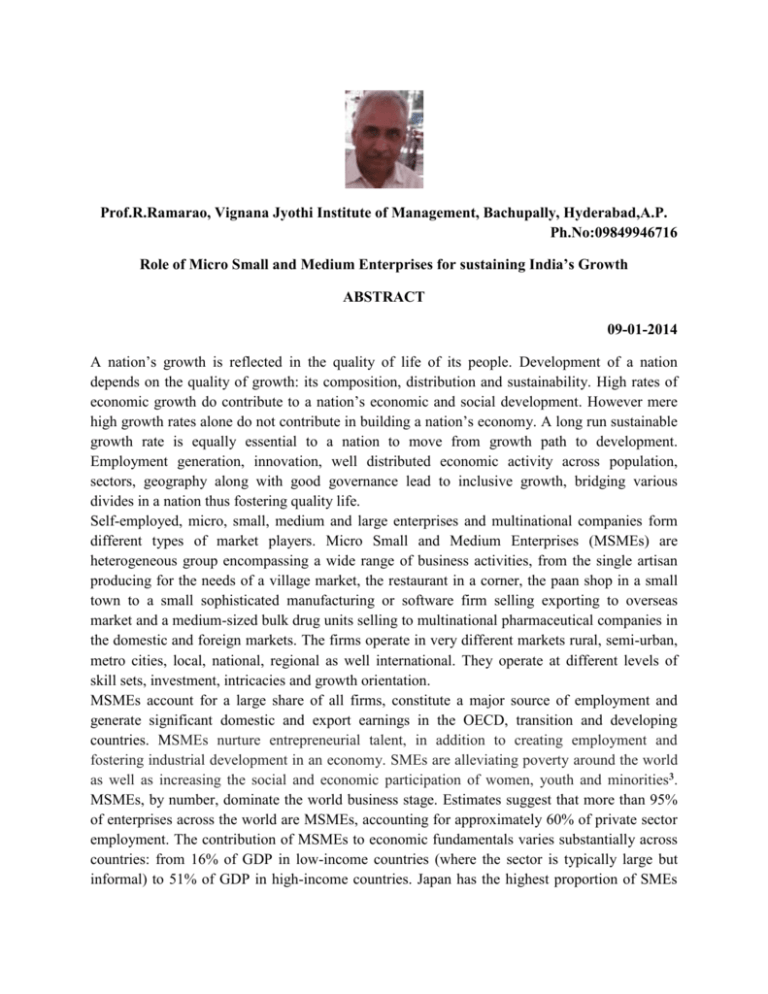
Prof.R.Ramarao, Vignana Jyothi Institute of Management, Bachupally, Hyderabad,A.P. Ph.No:09849946716 Role of Micro Small and Medium Enterprises for sustaining India’s Growth ABSTRACT 09-01-2014 A nation’s growth is reflected in the quality of life of its people. Development of a nation depends on the quality of growth: its composition, distribution and sustainability. High rates of economic growth do contribute to a nation’s economic and social development. However mere high growth rates alone do not contribute in building a nation’s economy. A long run sustainable growth rate is equally essential to a nation to move from growth path to development. Employment generation, innovation, well distributed economic activity across population, sectors, geography along with good governance lead to inclusive growth, bridging various divides in a nation thus fostering quality life. Self-employed, micro, small, medium and large enterprises and multinational companies form different types of market players. Micro Small and Medium Enterprises (MSMEs) are heterogeneous group encompassing a wide range of business activities, from the single artisan producing for the needs of a village market, the restaurant in a corner, the paan shop in a small town to a small sophisticated manufacturing or software firm selling exporting to overseas market and a medium-sized bulk drug units selling to multinational pharmaceutical companies in the domestic and foreign markets. The firms operate in very different markets rural, semi-urban, metro cities, local, national, regional as well international. They operate at different levels of skill sets, investment, intricacies and growth orientation. MSMEs account for a large share of all firms, constitute a major source of employment and generate significant domestic and export earnings in the OECD, transition and developing countries. MSMEs nurture entrepreneurial talent, in addition to creating employment and fostering industrial development in an economy. SMEs are alleviating poverty around the world as well as increasing the social and economic participation of women, youth and minorities3. MSMEs, by number, dominate the world business stage. Estimates suggest that more than 95% of enterprises across the world are MSMEs, accounting for approximately 60% of private sector employment. The contribution of MSMEs to economic fundamentals varies substantially across countries: from 16% of GDP in low-income countries (where the sector is typically large but informal) to 51% of GDP in high-income countries. Japan has the highest proportion of SMEs among the industrialized countries, accounting for more than 99% of total enterprises. In South Africa, it is estimated that 91% of the formal business entities are MSMEs. Worldwide MSMEs account for 52% of private sector value added, which provides a reasonable estimate for the sector’s global economic contribution Thus they become important players in developing countries and economies with high unemployment MSMEs are generally more common in rural areas than larger businesses especially in developing countries like India, thus providing much-needed employment in rural areas. In India Manufacturing SMEs accounted for around 40% of industrial output, and 40% of all exports along with large employment generation. Service sectors are by far the most important contributors, accounting for 79% of SMEs’ contribution to GDP in United States. India is a growing service economy and thus provides an opportunity for SMEs growth and achieve balanced growth. SMEs can in fact become the engines that sustain growth for long-term development for India. When growth becomes stronger, SMEs gradually assume a key role in industrial development and restructuring. They can satisfy the increasing local demand for services, which allows increasing specialization, and furthermore support larger enterprises with services and inputs. India will have to take lessons from global phenomenon wherein increase in contribution of MSMEs is clearly visible for growth in developed countries than that for growth in developing countries. It is a clear and one of the time tested paths for India to adopt and grow through MSME route as a means for the nation to have a sustainable growth and achieve the goal of joining the league of developed nations. --------------------------------------------------------------------------------------------------------------------Bibliography: 1. OECD(2004): ‘Promoting Entrepreneurship And Innovative Smes In A Global Economy: Towards A More Responsible And Inclusive Globalisation’; Istanbul, Turkey 3-5 June 2004 2. Edinburgh Group: ‘Growing the global economy through SMEs’; Edinburg,May 2003 3. Abe Masato etal: ‘Policy Guide Book for SME Development in Asia and the Pacific’,UNESCO,December 2012 4. Mankiw Gregory N: ‘The Growth of Nations’-Harvard University,1995

